Emily Lakdawalla • Feb 07, 2005
They Were the First, and the Last, to Hear from Huygens
On January 14, 2005, the eyes of the world were on the European Space Operations Centre in Darmstadt, Germany, where Huygens mission operators were anxiously awaiting news from Huygens. Would the little probe -- a mission built in seventeen countries, more than twenty years in the making -- be a success, or would it prove a repeat of the heartbreaking silence of Beagle 2? Huygens was due to enter Titan's atmosphere at 09:06 UTC, but Cassini would not begin transmitting the Huygens data back to Earth until 13:50 UTC. It would take another 67 minutes for the data to traverse the distance to Earth, so the first bits of data were not due to arrive on Earth until 15:17 UTC.
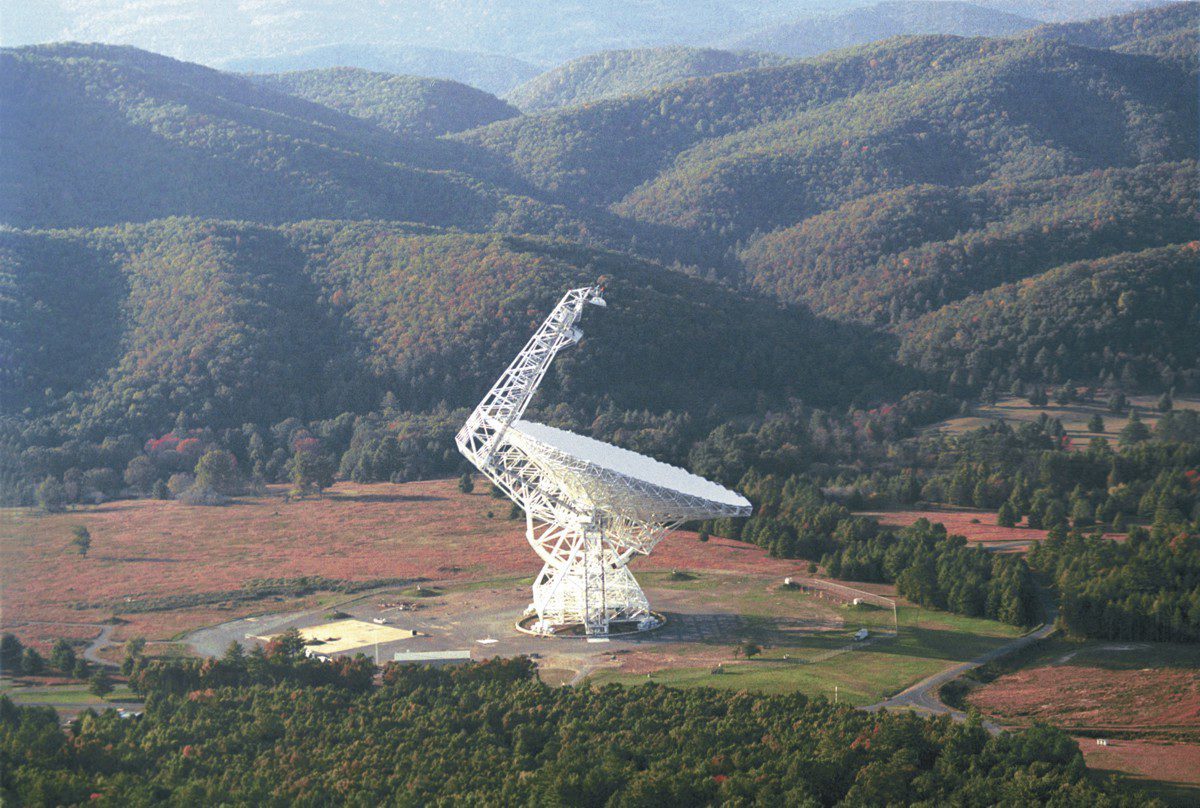
But Huygens mission planners had an ace up their sleeve. Thanks to great strides made in the science of radio astronomy over the past decade, they hoped to get a sneak preview of the signal from Huygens. In order to do that, they would first have to receive and record a radio signal that was not strong to begin with, only 3.5 Watts, attenuated by its travel across the 1,200 million kilometers (750 million miles) of empty space that lay between Titan and the Earth. They would have to employ specially designed radio receivers that could sift through the data -- recorded at 500 Megabits per second (that's almost 4,000 times as much data as is present in a typical mp3 music file) -- and detect this faint signal in real time.
Scanning the Heavens in West Virginia
At 09:06 UTC, when Huygens was just reaching Titan's atmosphere and most of the Huygens scientists and engineers were biting their fingernails in Darmstadt, Sami Asmar and a colleague were preparing for an eventful day at the 100-meter Robert C. Byrd Green Bank Telescope, part of the National Radio Astronomy Observatory (NRAO), in West Virginia, USA. It was just after 4 a.m., local time. Asmar, a radio scientist from the Jet Propulsion Laboratory (JPL), is a co-investigator on Huygens' Doppler Wind Experiment. He was in charge of the difficult task of attempting to detect Huygens' signal, which would only barely rise above background noise. The difficult detection would be helped in part by a fortunate coincidence: Saturn was just at opposition, so would be on the opposite side of the Earth from the radio-noisy Sun, and the two planets were pretty much as close to each other as they get.
"UTC" stands for "Universal Time Coordinate." UTC is based on atomic clocks and is the time standard used by astronomical observers and space mission planners. It is more accurate than Greenwich Mean Time (GMT), which is based on the motion and rotation of the Earth, but UTC and GMT rarely differ by more than a few seconds.
On Jan. 14 at 09:06 UTC it was:
10:06 in Darmstadt, Germany
09:06 in London, England
04:06 in West Virginia
01:06 in Pasadena, California
20:06 in Sydney, Australia
Despite the fortuitous planetary alignment, the situation at Green Bank did not look good. "It was very cold, to start with," Asmar recalls. "We expected a snowstorm and high winds." That spelled trouble for the experiment, because the telescope could not be operated safely if the winds got too high, not to mention the effect that snow would have on the quality of the radio signal. "We were very concerned, we were watching the weather. We thought we may not pull this off. The Green Bank staff were prepared to bring in their Chief Engineer to get an exemption to allow us to maintain tracking through the wind. They were so excited about making this work that they had this guy on hold in case they needed it. It never got to that; the weather turned around, and the snowstorm was delayed by a day."
Asmar was there to watch over the Radio Science Receiver, a device on loan from NASA's Deep Space Network. "It is what we would use for the actual detection in real time. Reception, recording, and detection are different things. The idea originally was that we would just receive and record the data, and not have any real time visibility or detection; we'd just record it and bring it back to JPL. Weeks to months later we'd get funding to process it, and get a bunch of analysts on it to see what came out.
"With the Radio Science Receiver, it had the ability to give us real time information as to what was going on. But to do that I would have to configure it very carefully. There were a lot of parameters that had to be done just right. We had so many meetings and discussions at JPL about what was the optimum configuration that I got nervous about getting it wrong. Because at the end they just said 'well, just do what you feel you need to do.'"
If all went well at Titan, Huygens would turn on her transmitters at 09:11 UTC. She had two, known as Channel A and Channel B. One of the two, Channel A, was fitted with a special Ultrastable Oscillator that would make the frequency of the carrier signal steady enough that its Doppler shift could be measured a thousand times more accurately than the signal from the ordinary crystal oscillator on Channel B. The Ultrastable Oscillator was part of the Doppler Wind Experiment, which would use the measured Doppler shift of the Huygens signal to figure out how fast the winds on Titan were blowing the probe sideways as she descended under her parachute. The Radio Science receiver also had an Ultrastable Oscillator, as did the Channel A receiver onboard Cassini.
"We were doing two things," Asmar explains. "We were hoping to confirm to the project 5 or 6 hours in advance that their probe was alive and kicking. But our original purpose was to enhance the Doppler Wind Experiment. The original experiment would be one vector, from Huygens to Cassini. What we were trying to do was a Doppler measurement of the wind at another vector [from Huygens to Earth]. The combination of the two would enhance the science data."
The Moment of Truth
As the morning progressed, the control room at Green Bank began to fill. In addition to Asmar and his colleagues, there were a few European workers there to conduct a Very Long Baseline Interferometry experiment (more on that below), and curious Green Bank staff members who could not stay away.
The faint signal from Huygens would take 67 minutes to reach Earth from Titan, and should arrive at 10:18 UTC, or 5:18 a.m. in West Virginia. Shortly before the moment of truth, an open phone conference was established between Green Bank, JPL, five other radio telescopes participating in the observations (Kitt Peak, Arizona; Pie Town, New Mexico; Owens Valley, California; Mauna Kea, Hawaii; and the Parkes Observatory in Australia); and Darmstadt. In Darmstadt, three different stakeholders were on the line: Leonid Gurvits, who had marshaled the worldwide radio telescope observation efforts; Jean-Pierre Lebreton, the Huygens Project Scientist; and Mike Bird, the Principal Investigator for the Huygens Doppler Wind Experiment.
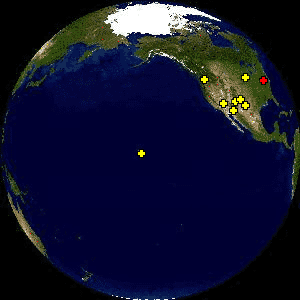
"On the phone line there was small talk and so on, and then suddenly it got quiet," Asmar recalls. "The time had come when we should actually see the first signal, and all the spectators' attention came to me. Nobody said anything, but you could see it in their eyes, they were all saying, 'okay, do you see anything?'"
In fact, Asmar did see something, exactly when the timeline predicted that the signal should arrive. "The trick with detecting a very weak signal from amid a lot of noise is that you may see it, and think it's a real signal, and then it'll disappear, so you would have a false detection. So I was resisting the temptation to say something when I saw it the first time. The fact that we saw it exactly when it was expected to appear made me more worried than relieved, because usually these things are not timed exactly. I kind of had to hold myself back. In my mind, I knew that this is a signal, but I waited." When Asmar had convinced himself that he had truly seen the signal, he announced over the phone line, "I see the probe signal, it has refreshed three times, this is real!"
With people cheering in the Green Bank control room, Asmar could finally relax. "Then Jean-Pierre [Lebreton] got on the phone line, and he was so emotional and so relieved," Asmar recalls. "He was like, 'How can I thank you, this is great, what a great relief, we know it's alive and transmitting.' In my mind it wasn't until that conversation that I felt this was real, that it happened, and we are now part of history and something very significant was just completed. It wasn't completed, this was just the start, and the telemetry was not going to come in for hours later, but we didn't care about that. This was our contribution."
For Lebreton, the gift of the signal reception at Green Bank was "an incredible thing," he says. "It was the latest technology in terms of radio receivers and in terms of data processing. It was an experiment. We were not sure it would succeed." Doppler Wind Experiment Principal Investigator Mike Bird even lost a bet over the successful detection at Green Bank.
Green Bank Was Just the Beginning
Meanwhile, 16 other radio telescopes around the world were trained on Huygens. Very Long Baseline Array antennas at Kitt Peak, Pie Town, Owens Valley, and Mauna Kea were quietly recording the data for later analysis, tracking Saturn across the night sky. Across the Pacific, radio astronomers in Japan and China waited for the Earth to turn and Saturn to rise in the east. In Australia, a team at Parkes stood by with a second Radio Science Receiver, getting ready to perform the real-time detection feat a second time. Astronomers also recorded data at the Mopra telescope in Coonabarabran, New South Wales; in Ceduna, South Australia; and in Hobart, Tasmania. "Pretty much everyone that could see Saturn at that time was watching," says University of Tasmania radio astronomer John Dickey, who was watching the Ceduna telescope.
As the Eastern Hemisphere waited for the Sun to set and Saturn to rise, the signal continued as a steady peak at Green Bank. With the initial detection under his belt, Asmar could look for subtleties within the data. When events on Titan caused Huygens' velocity to change abruptly, Asmar could see the effect of the sudden velocity changes on the Doppler shift of Huygens' carrier signal. "There were four critical events that we were after," he explains. "One was the first signal, first light. The second was the detection of the [deployment of] the stabilization chute. We detected that by seeing the shift in the Doppler signal and I announced it. The landing or impact would be the third one. The fourth one would be the end of it, when the battery died."
Asmar's announcement of the detection of the parachute deployment was relayed by email to the rest of the radio telescope operators around the world, as Dickey remembers. "That was one of the most exciting things to hear in the emails during our run, 'the parachute has opened.' They could see the Doppler shift change that clearly."
On Jan. 14 at 12:10 UTC it was:
13:10 in Darmstadt, Germany
12:10 in London, England
07:10 in West Virginia
04:06 in Pasadena, California
23:10 in Sydney, Australia
Finally, at about 12:10 UTC, Saturn set over the western horizon at Green Bank, ending the experiment. For the next 20 minutes, there would be no real-time information on the detection of Huygens' signal. Saturn had already risen in Australia and Japan, so most of the radio telescopes in those countries were quietly recording the signal. But the second Radio Science Receiver had been sent to the largest dish in Australia, 64-meter Parkes, and Parkes would be unable to see Saturn until 12:30.
The World Hears That Huygens Is Alive
While they waited for the Parkes detection, Lebreton left Huygens Mission Control to go to the press room and announce his happy news to the world at 12:30 UTC (13:30 local time). "For us, the morning was good. We have a signal. We know that Huygens is alive, so the dream is alive," Lebreton gushed. "Huygens is already an engineering success. We shall see later in the afternoon if this is a science success." He was cautious about proclaiming full success, because back at Green Bank, Asmar couldn't tell whether or not the barely detectable signal actually carried data. But Lebreton could say that "what we know for sure is that we have had a successful entry, and we have deployed one, maybe two parachutes. We have got the signal from the Green Bank telescope from [10:18 to] 12:10, so the probe has been transmitting for two hours."
At the moment that the press conference began in Darmstadt, the Earth rotated enough to bring Saturn above the 30-degree mark at Parkes, and the signal was immediately detected there too. Someone from mission control ran to the press conference to whisper the news to Lebreton. He announced, "Huygens has now been acquired in Australia! The telescope which was the subject of the movie 'The Dish' acquired the signal at 13:30 local time. So we clearly have had an engineering success. Give us a few hours to give you a little of the data. We will work very hard tonight and tomorrow to tell you as much as we can tell."
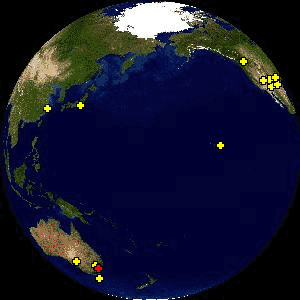
However, Lebreton could not resist announcing what he thought was one scientific success. Because the Doppler Wind Experiment team could get science from the Doppler shift of the carrier signal detected by Earth-based telescopes (which was the whole reason for Asmar's presence at Green Bank in the first place), Lebreton could announce that that experiment had worked. "Congratulations, Mike Bird, you now have data," he said happily. That announcement would later prove premature.
Although Asmar's observing was over at Green Bank, West Virginia, he kept monitoring the status of the signal reception at Parkes. So was Dickey, in Hobart, Tasmania. "This was a striking experiment," Dickey says. "For those critical four or five hours, the emails were sizzling in from China, from Japan, and from Hawaii, and in from Green Bank, West Virginia, and from all of our telescopes here in Australia. And it was -- not quite heart-stopping, but it was pretty exciting, I have to say. It was one of the more exciting experiments I've done. All science is an international effort, and radio astronomy has always been an international community because it's a small one, so we all have to talk to each other across boundaries. But still, it was exciting and fascinating to see all the world's radio observatories come together."
It Keeps Going, and Going, and Going...
Back on Titan, 1200 million kilometers (750 million miles) away, Huygens touched down at about 11:36 UTC, about 12 minutes later than expected. The change in the Doppler shift was detected 67 minutes later at Parkes, at 12:43 UTC, 23:43 local time. Most observers expected Huygens to fail on impact, or survive at most a few minutes to a half an hour before the batteries died. "But that never happened," Asmar says. "Parkes ended up receiving the signal longer than we expected. We thought the batteries would die but it just kept going, and going, and going."
The longevity of Huygens' signal was thrilling, but also problematic. Back on Titan, the Cassini orbiter, which was recording the data transmitted on Huygens' signal, disappeared over Huygens' local horizon at about 13:37 UTC. This was two hours after Huygens had touched down, and long before the probe stopped transmitting. No further data would ever be received from Huygens, but the Channel A carrier signal was still being received on Earth. Although Huygens was no longer moving, Titan was. By measuring the Doppler shift of the signal after Huygens landed, when she was presumably sitting still, the Doppler Wind Experiment team could calibrate their measurements of her motion during her descent. In addition, radio astronomers could use the highly stable beacon from Titan's surface to determine Titan's rotation rate extremely precisely, and learn how long Huygens lasted. But only if their radio telescopes could continue to see Titan.
With Huygens having disappeared around the globe of Titan from the point of view of Cassini, the orbiter write-protected her solid-state recorders and then turned toward Earth. She began transmitting data to Earth at 14:10 UTC. NASA's Deep Space Network dish at Canberra, Australia was ready and waiting to receive the Huygens data, and as soon as it hit the ground at 15:17 UTC, Canberra relayed the data to JPL in California, who transmitted it on to Darmstadt, Germany.
Data from Channel A were expected to begin arriving first. The world watched the TV feed from Huygens Mission Control in Darmstadt. As 15:17 UTC came and went, the expected elation was not visible on the faces of mission operators; instead, there was only puzzlement. A rumor began to circulate among the onsite reporters that the data stream from Huygens consisted of "nothing but zeroes." About 5 minutes later, though, the people in mission control began to celebrate as data from Channel B came in loud and clear, and the rumor-mongers were momentarily silenced.
But something had happened to the Channel A data. At a press conference a few minutes later, Mission Operations Manager Claudio Sollazzo reported that "on Channel B, not one packet of data was lost throughout the probe mission." But, he added, "we do not have much information on what has happened to Channel A." If Channel A was completely lost, he said, all of the science experiments would still have data from Channel B, except the Doppler Wind Experiment. The Channel A problem was a sour note, but the arrival of the Channel B data combined with the strength of the Channel A signal as received by Green Bank and Parkes clearly showed that Huygens had worked flawlessly.
Scrambling Telescopes
Saturn was sinking in the western sky in Australia, and the signal was still being received loud and clear at Parkes. "That was a surprise for everybody," says Leonid Gurvits, who was in Darmstadt, watching over the worldwide network of 17 radio telescopes that he had organized for the Very Long Baseline Interferometry effort. "We were told by the mission that it was practical to observe Huygens for just 3 and a half hours after the atmosphere entry. So we scheduled all the telescopes in the network not for 3 and a half hours, but for 6 hours. We began observations at 9:30 UTC, and our schedule ended at 15:30. But Huygens lived even longer than that! Nobody, just nobody expected that."
Saturn would set below the 30-degree horizon limit at Parkes just before 16:00 UTC, 3:00 a.m. local time. "When it became clear that Huygens would transmit even longer than they could be seen in Hawaii, Australia, and eastern Asia, then we decided to try to do something," Gurvits says. He would need to find telescopes to the west of China. "Which telescopes to use? Following the rotation of the Earth, the next suitable position for a telescope would be somewhere in middle Asia, in India for example, or in Russia, but there are no Huygens-compatible telescopes there. The next would be telescopes in Europe. So we tried to arrange something absolutely unexpected."
On Jan. 14 at 16:00 UTC it was:
17:00 in Darmstadt, Germany
16:00 in London, England
11:00 in West Virginia
08:00 in Pasadena, California
Jan 15 at 03:06 in Sydney, Australia
Gurvits and his colleagues at the Joint Institute for VLBI in Europe (JIVE) called the operators of telescopes in Westerbork, the Netherlands; Onsala, Sweden; Medicina, Italy; and Wettzell, Germany. They authorized the telescopes to stop performing any current observations, and asked them to try to aim their dishes at Titan and tune their receivers for Huygens' signal.
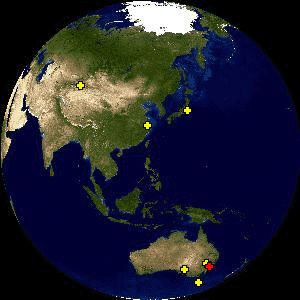
"We said, 'this is something strange, and we need your telescope badly.' All the telescopes we spoke to said they would do their best," Gurvits says. "But, it would take a miracle, and miracles are very rare. They were not prepared at all. The setting of telescope receivers for Huygens was very, very unusual." The problem was that Huygens transmitted at a frequency known as S-band radio (2040 MHz), which is much lower than the frequencies that are ordinarily used for radio astronomy. Some radio telescopes can be tuned to this frequency, but some simply can't. In fact, the reason that Sami Asmar had observed Huygens at the NRAO's Green Bank Telescope rather than NASA's own Deep Space Network was that the Deep Space Network's radio receivers could not tune down to S-band frequencies. Gurvits likens the effort to trying to turn an analog dial on an FM radio down past its lowest point. In addition to the low frequency, Huygens' broadcast had a specific polarization, called Left Circular Polarized, or LCP. In order for the European telescopes to adjust the polarization of their receivers in time to receive the signal, "engineers just ran to their telescopes and climbed the telescopes and turned the polarizers by hand," Gurvits says. "Never is this done in normal practice. It was really heroic on their side."
Saturn set below Parkes' horizon at 16:00 UTC, though it should still have been visible to the other Australian, Japanese and Chinese telescopes for some time longer. But only Green Bank and Parkes had real-time detection capability, so once Saturn set at Parkes the radio recording would be done in the dark, with no knowledge of Huygens' final moment possible until the data were analyzed later.
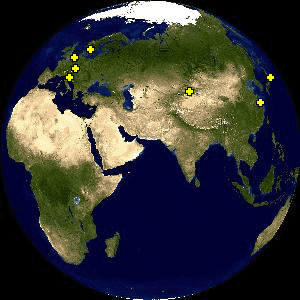
Things Looked Bad for the Doppler Wind Experiment
Cassini continued to transmit copy after copy of the Huygens data to Earth for many more hours. The data was received by all three Deep Space Network stations: Canberra, Australia; Madrid, Spain; and Goldstone, California. The first images were presented to the public at 20:00 UTC, less than five hours after the data had first reached Earth. Huygens was established as a ground-breaking success, a milestone in the exploration of our solar system. But the news wasn't all good.
By the time morning arrived in Darmstadt on January 15, the horrifying truth about Channel A had become clear. "They had forgotten to turn my instrument on, on Cassini," Bird says. Somehow, the command to turn on the Receiver Ultrastable Oscillator, or RUSO, aboard Cassini had not been included in the Huygens mission command sequence provided by the European Space Operations Centre to Cassini.
The damage to the Doppler Wind Experiment was irreversible -- or so it seemed at the time. "Now we have Doppler observations only in the one direction, from Huygens to Earth," Bird said. The loss of Channel A "is something that we can never recover. It was our hope that with just these two different geometries, we would be able to determine the entire wind profile, including the zonal [east-west] and the meridian [north-south] flow. We are not going to be able to do that now with just the Doppler."
Very Long Baseline Interferometry to the Rescue
But Leonid Gurvits was about to deliver a priceless gift to Bird. He and his colleagues at JIVE had arranged to perform a stunning feat on the cutting edge of technological capability, even "a little bit beyond that limit." Very Long Baseline Interferometry (VLBI) depends upon signals being recorded at two distantly separated radio telescopes simultaneously. When the two signals are interfered, producing a characteristic pattern that radio astronomers call "fringes," the X and Y position of a radio source can be measured on the sky to unprecedented accuracy. But the technique is computationally challenging. It requires incredibly accurate clocks, stable radio transmitters and receivers, and fantastic amounts of data. With a data rate of 500 Megabits per second, the data recorded at the Parkes telescope alone amounted to several Terabytes. (One Terabyte is 1024 Gigabytes.) It customarily takes weeks or months for radio astronomers to process the data from multiple telescopes in a Very Long Baseline array. Gurvits wanted to try to do it overnight.
In order to interfere the signals, Gurvits would need to get the data from Parkes and another of the Australian telescopes, Mopra, to the Joint Institute for VLBI in Europe (JIVE), located in Dwingeloo, in the Netherlands -- almost exactly on the opposite side of the Earth. It would have taken an airplane nearly a day to make the trip and carry the disks to JIVE. "With Huygens," Gurvits says, "We wanted to have the results as soon as possible. We need Australian data within hours in the Netherlands. There is a recent initiative in the world of VLBI, called eVLBI or electronic VLBI, that attempts to transfer huge amounts of data electronically. We jointly arranged with Canadian, Australian, American, and European operators of the network -- not radio astronomers, they are research and development and commercial entities. They all replied very positively and they said they would do their best. The next task was to bring the data recorded at Parkes and Mopra, to a place from which a powerful computer can transmit data to Europe. But Parkes and Mopra are some 500 kilometers away from Sydney."
The arrangements that Gurvits made sound like the climax of a movie. "A chartered plane was waiting at the airfield near one of the telescopes in Mopra, and just minutes after completion of recording, this plane took off, flying to another telescope 500 kilometers [300 miles] away, Parkes. The plane landed there, where there was another car with another disk, and the plane collected this disk and flew another 500 kilometers to Sydney. Then Chris Phillips and colleagues from the Australian Telescope National Facility, brought these disks to their headquarters. An hour later they began transmission. Two hours later the data were in Dwingeloo and by then it was already 2:00 a.m. local time in Europe. It took another two hours in the middle of night for our team in Dwingeloo to correlate the data, with the assistance of another chap in Finland, at the University of Helsinki, who was sitting there in Helsinki but was logged on our computers in Dwingeloo helping to translate data from Australian format to European format. By 5:00 a.m. the data were ready, by 6:00 we had fringes, confirming that the VLBI setup for observing Huygens was right. An hour later I was able to announce in Darmstadt that we got fringes."
"Frankly, I did not expect it," Lebreton says. "Leonid [Gurvits] had phoned me only the day before to tell me to expect it, and he really gave this to me as a surprise. I said to myself, 'gosh, are they going to succeed?' And yes, they did! All in all this experiment worked extremely well. It was a really perfect experiment. Leonid deserves a great deal of credit."
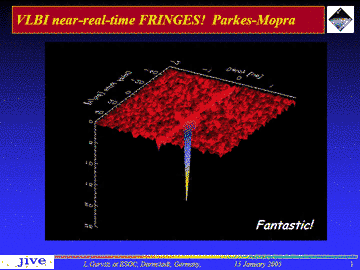
Having worked through the night without sleep, Lebreton, Gurvits, and other scientists returned to the press room in Darmstadt at 11:00 a.m. local time to present the astonishing first results from Huygens. Gurvits displayed a graph to the press showing the fringes that the VLBI team had produced from a distant quasar that the telescopes had used as a calibration source. "Now, since we know that the signal from Huygens is there, and we have fringes on the calibator, nothing on Earth -- or Titan! -- can stop us from getting fringes on the Huygens signal. That means that eventually we will deliver our goal, which is we will detect the position of Huygens with 1-kilometer [0.5-mile] accuracy."
In other words, the VLBI experiment will recover the extra information that was lost to the Doppler Wind Experiment team with the loss of Channel A. It was a cutting-edge experiment, made possible only by the recent rapid development of the necessary technology; initial studies to determine whether the experiment was feasible began only two years ago. "It paid off," Bird says, "because we saw the signal, and now we have the data that we want. All of the data will be combined in the final analysis to produce the experiment we wanted to, to determine the full motion of the probe on Titan."
Looking Backward
Asmar clearly feels honored to have been a part of the successful tracking effort and the recovery of the science goals of Huygens. "It wasn't until many hours later that we knew about the failure. When I found out, I thought -- we [radio scientists] are the Doppler Wind Experiment. And now we've got a nickname, 'Channel C.'"
The radio astronomy support of the Huygens mission is co-ordinated by JIVE and JPL and involves the Netherlands Foundation for Research in Astronomy (ASTRON, The Netherlands), the University of Bonn (Germany), Helsinki University of Technology (Espoo, Finland), the MERLIN National Facility (Jodrell Bank, UK), the Onsala Space Observatory (Sweden), the NASA Jet Propulsion Laboratory (Pasadena, USA), the National Radio Astronomy Observatory (NRAO, Green Bank, USA, and Socorro, USA), the CSIRO Australia Telescope National Facility (ATNF, Sydney, Australia), the University of Tasmania (Hobart, Australia), the National Astronomical Observatories of China, the Shanghai Astronomical Observatory (Shanghai and Urumqi, China) and the National Institute of Information and Communications Technologies (Kashima Space Research Center, Japan).
For Gurvits, he and the other radio astronomers in Europe, the USA, China, Japan, and Australia felt they had been involved in a unique collaboration by working on the VLBI observations of Huygens. "That's something very, very special about VLBI. It's a very difficult technique but at the same time it's so nice when you see the result, and there is a very special team spirit. The total number is, I don't know, 250, maybe 300, not more than that, and we all know each other. And that indeed allows us to work very efficiently and very closely."
John Dickey, in Tasmania, echoes the sense of a common mission among the world's radio astronomers. "It was important for us to be involved, and we felt very keenly the importance and the stark significance of it all. Once we all got into it, we really wanted it to work. First, because we don't really do that much planetary science; radio astronomers are mostly galactic and extragalactic. But once it dawned on us, the real profound significance of this mission in our lifetimes, we all wanted to be part of it. I've been teaching astronomy for 25 years. I'm not a planetary astronomer at all. But I believe that the exploration of the solar system that we have done in the last 30 years has been the greatest contribution that our civilization has made to human history. I think in 2000 years, when people look back, this will be the one thing that they remember us for."
Hear radio scientist Sami Asmar's account of hearing Huygens' descent on Planetary Radio.
Let’s Go Beyond The Horizon
Every success in space exploration is the result of the community of space enthusiasts, like you, who believe it is important. You can help usher in the next great era of space exploration with your gift today.
Donate Today

 Explore Worlds
Explore Worlds Find Life
Find Life Defend Earth
Defend Earth

